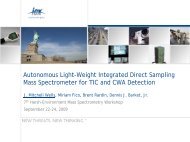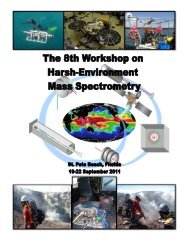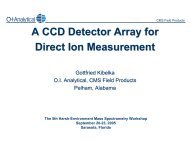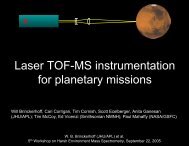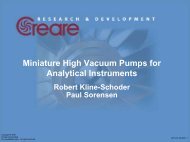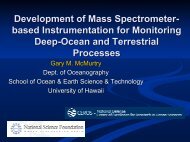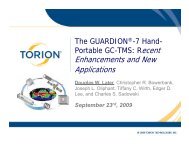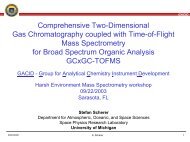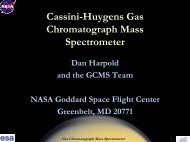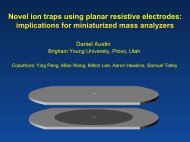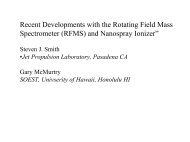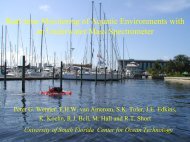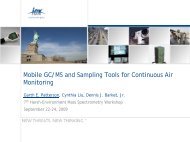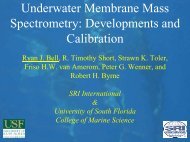View or download presentation - Harsh-Environment Mass ...
View or download presentation - Harsh-Environment Mass ...
View or download presentation - Harsh-Environment Mass ...
You also want an ePaper? Increase the reach of your titles
YUMPU automatically turns print PDFs into web optimized ePapers that Google loves.
Turbomolecular Pumps f<strong>or</strong> <strong>Harsh</strong><br />
<strong>Environment</strong>s<br />
Marc Kenton<br />
Creare, Inc.<br />
Hanover, NH<br />
JPL/NASA Miniature Vacuum Pumps<br />
W<strong>or</strong>kshop<br />
March 28, 2002<br />
1 MTG-02-03-1411/4260
Turbomolecular Pump Advantages<br />
• Supply clean vacuum at high flow rates<br />
• Pump all species, including noble gasses<br />
• Low power consumption<br />
• Small size and mass<br />
2 MTG-02-03-1411/4260
Miniaturization Challenges<br />
• Tip Speeds<br />
– Must be significant fraction of the mean molecular speed<br />
– F<strong>or</strong> a 2.5 cm pump, speeds > 200,000 rpm are needed<br />
– This can lead to:<br />
» Reduced bearing life<br />
» High rot<strong>or</strong>dynamic loads due to environmental<br />
vibration <strong>or</strong> shock<br />
» High power consumption<br />
• Rot<strong>or</strong>/Stat<strong>or</strong> Clearances<br />
– Must be large enough to accommodate manufacturing<br />
tolerances and vibration<br />
– Must be small enough not to degrade pump perf<strong>or</strong>mance<br />
3 MTG-02-03-1411/4260
Creare Pump Projects<br />
• 5 L/s miniature turbomolecular pump (complete)<br />
• 5 L/s ruggedized turbo-drag pump (ongoing)<br />
• 1.5 L/s extremely miniaturized turbo-drag pump<br />
(ongoing)<br />
4 MTG-02-03-1411/4260
Design Eff<strong>or</strong>ts<br />
• Miniaturization requires optimization of:<br />
– Mot<strong>or</strong><br />
– Turbopump rot<strong>or</strong> and stat<strong>or</strong><br />
– Molecular drag stage<br />
• Analytical optimization eff<strong>or</strong>ts include:<br />
– Electromagnetic analysis of mot<strong>or</strong><br />
– Structural analysis of pump rot<strong>or</strong>s<br />
– Bearing life analysis<br />
– Random vibration and rot<strong>or</strong>dynamic analyses<br />
– Evaluation of turbo and drag stage pumping perf<strong>or</strong>mance<br />
at small size scales<br />
5 MTG-02-03-1411/4260
Experiments Complement Analysis<br />
• Testing is necessary to complement design<br />
eff<strong>or</strong>ts and verify analytical models:<br />
– Mot<strong>or</strong> (bearing) life tests<br />
– Tests of alternative magnet designs f<strong>or</strong> mot<strong>or</strong><br />
– Bench tests of individual turbo- and drag-pumping stages<br />
– Testing of completed pumps<br />
6 MTG-02-03-1411/4260
5 L/s TMP<br />
• Power consumption: 1 W<br />
• Rotational speed: 100 Krpm<br />
• Discharge press: .01-.2 T<strong>or</strong>r<br />
• Compression ratio (N 2 ): 2x10 6<br />
• Volumetric flow (air): >4 L/sec<br />
• Volume: 165 cm 3<br />
• <strong>Mass</strong>: 1 year<br />
7 MTG-02-03-1411/4260
Ongoing projects<br />
• Ruggedized 5 L/s turbo-drag pump<br />
(NASA/KSC)<br />
• “C-cell” turbo-drag pump (NASA/JPL)<br />
8 MTG-02-03-1411/4260
Ruggedized Pump<br />
• Designed to withstand vibration loads during<br />
launch of space shuttle<br />
– Will supp<strong>or</strong>t use of MS f<strong>or</strong> hazardous gas detection<br />
• Utilizes “inside-out” (exteri<strong>or</strong> rot<strong>or</strong>) mot<strong>or</strong><br />
– Avoids need f<strong>or</strong> conventional, overhung pump rot<strong>or</strong><br />
– Allows very stiff rot<strong>or</strong><br />
» critical frequencies well above exciting frequencies<br />
» reduced possibility of rot<strong>or</strong>/stat<strong>or</strong> contact<br />
9 MTG-02-03-1411/4260
Ruggedized Pump<br />
10 MTG-02-03-1411/4260
Ruggedized Pump: Status<br />
• Project began 11/02<br />
• Mot<strong>or</strong> assembled and being tested<br />
11 MTG-02-03-1411/4260
“C-cell” Turbo-Drag Pump<br />
• Scaled down version of 5 L/s pump<br />
– Fact<strong>or</strong> of 2 reduction in all dimensions<br />
– Pumping speed ~1.5 L/s<br />
– Design compression ratio f<strong>or</strong> nitrogen > 10 9<br />
• Operates at twice the rotational speed of the<br />
5 L/s pump<br />
– 200,000 rpm<br />
– Hybrid ceramic bearings<br />
• Includes drag stage to allow discharge to Mars<br />
atmosphere (10 T<strong>or</strong>r)<br />
12 MTG-02-03-1411/4260
Comparison of Turbo-Pump Envelopes<br />
13 MTG-02-03-1411/4260
Turbo-Drag Version<br />
14 MTG-02-03-1411/4260
Rot<strong>or</strong>/Stat<strong>or</strong>/Rot<strong>or</strong> Test Article<br />
15 MTG-02-03-1411/4260
Rot<strong>or</strong>/Stat<strong>or</strong>/Rot<strong>or</strong> Compression Ratio<br />
12<br />
10<br />
8<br />
6<br />
4<br />
Compression Ratio<br />
2<br />
0<br />
150 160 170 180 190 200 210<br />
Data<br />
Model<br />
Rotational speed (Krpm)<br />
16 MTG-02-03-1411/4260
Reducing Power Consumption<br />
• A key challenge of the miniature pump is<br />
achieving low power consumption<br />
• This requires careful attention to:<br />
– Mot<strong>or</strong> magnetic design<br />
– Drag stage design<br />
17 MTG-02-03-1411/4260
Mot<strong>or</strong> Design f<strong>or</strong> Low Power<br />
• As mot<strong>or</strong> size reduced, magnetic flux density<br />
in stat<strong>or</strong> substrate increases<br />
• This motivates use of materials having high<br />
saturation flux<br />
• Unf<strong>or</strong>tunately, such materials can have high<br />
c<strong>or</strong>e losses<br />
• Power consumption of initial design is too<br />
high (9 W) at 200 krpm<br />
• Careful magnetic redesign is key to reducing<br />
power consumption<br />
18 MTG-02-03-1411/4260
Prototype Mot<strong>or</strong> Magnetic Flux Density<br />
19 MTG-02-03-1411/4260
Drag Stage Design f<strong>or</strong> Low Power<br />
• Turbo-stages operate in molecular flow and<br />
require negligible power<br />
• Drag stage viscous losses will dominate<br />
power consumption if mot<strong>or</strong> is well-designed<br />
• Optimizing drag stage design requires careful<br />
trade-offs among ridge width between<br />
pumping channels and required pump length<br />
• Developed a flexible design tool based on<br />
models in literature to supp<strong>or</strong>t trade studies<br />
20 MTG-02-03-1411/4260
Drag Stage Test Data<br />
1<br />
0.1<br />
Pressure Gradient Across Stage, T<br />
0.01<br />
0.1 1 10<br />
Prediction<br />
Data<br />
Average pressure, T<strong>or</strong>r<br />
21 MTG-02-03-1411/4260
Current Status of “C-cell” Pump<br />
• Designing mot<strong>or</strong> f<strong>or</strong> reduced power<br />
consumption using am<strong>or</strong>phous metal alloy<br />
ribbon stat<strong>or</strong> materials<br />
• Constructed breadboard prototype f<strong>or</strong> mot<strong>or</strong><br />
controller<br />
• Testing individual drag stages designed f<strong>or</strong><br />
low viscous heating to qualify analytical<br />
model<br />
22 MTG-02-03-1411/4260
Conclusions<br />
• While turbomolecular pumps have highly<br />
desirable features, miniaturizing them raises a<br />
host of problems<br />
• These problems can be overcome with a highly<br />
multi-disciplinary approach that combines<br />
analytical eff<strong>or</strong>ts and experimentation<br />
23 MTG-02-03-1411/4260



